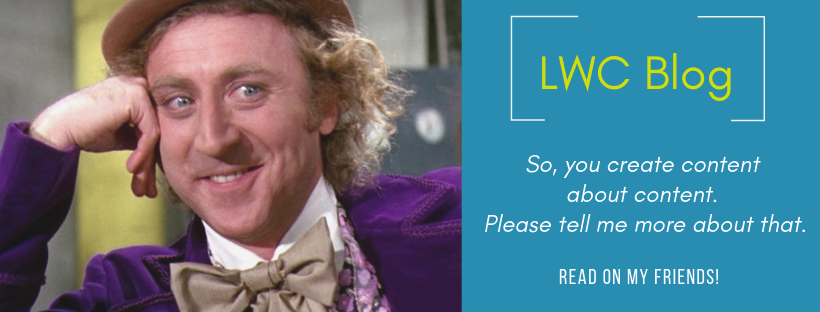
I’m going to go out on a limb here and assume that most of you have a blog. If you don’t have an existing blog, it’s important that you create one as part of your company’s overall content marketing strategy. In fact, I started writing a couple of blogs for my new website before I launched my website. That’s how much believe in this topic.
It’s simply a fact of life now: A company blog is a necessity when it comes to building your site’s authority, increasing inbound traffic, creating inbound links, being viewed as an expert in a particular field, and offering value to your audience.
Whether you have an existing blog or plan to start one, this article will help you get the most out of your current or future content planning.
But first things first… where do you start?
1. Understand Your Audience
Well, this seems rather obvious. Or does it? I don’t just mean who your audience is, necessarily — although having clearly defined personas is vitally important to any company’s content marketing strategy — but, more, what types of questions are they asking in relation to your industry or services that you can help answer.
So, how do you find out what your audience is asking? Try these suggestions:
Ask Them – That’s pretty straightforward. Also, don’t forget to hit up your sales team. They can be a wealth of information about questions they frequently get asked from clients or prospects.
Google Search Console – This site allows you to see the actual search queries that brought users to your site. It’s important that you check this site this periodically as it will help to shape your keyword strategy and aid in building topics surrounding frequently searched terms and phrases.
Google: Type any topic you’re thinking of writing about into Google’s search bar and scroll down the page to “People also ask.” This will give you more ideas of questions to answer in your blog about that topic.
Google Trends – You’ll want to see what’s trending for the keywords you are considering for your blog post. On this site, enter a few variations of your keyword to see which keywords are trending over time.
2. Choose Blog Topics Based on Your Focused Keywords
Now that you’ve identified the types of things your audience is looking for as it relates to your business or industry, it’s time to focus on the topics you want to build upon.
Here are some strategies for mapping out your content that you should consider:
- Identify and categorize all keywords for your organization. Try to ensure the list is as complete as possible.
- Perform a content audit. This will help you identify topic areas you are missing or that need further development.
- Fill in any content gaps or thin content that your audience is looking for.
Prioritize content development based on:
1) trending topics/keywords
2) content gaps
3) organic search ranking
Create a content calendar – this will help keep your team on target and provide a clear view into topics being developed, who is responsible, deadlines, and what channels the content will be distributed to.
3. Conduct Keyword Research
Keywords are the terms your company is known for. By identifying the right keywords, or keyword phrases, your marketing team will have the blueprint to create the right content for your target audiences and your company’s needs.
There are many online tools that exist today to help you identify keywords or keyword phrases that are easy to rank for, as well as the search volume and competition for these keywords or phrases. Try using sites like Moz Keyword Explorer, Alexa’s Keyword Difficulty tool, or SEMRush’s Keyword Magic Tool. Aim for high search volume and low competition.
4. Write a Great Headline
Having a great headline for your blog article will help gain more views and drive more traffic to your website. The headline is how we entice an audience into reading our ad, newsletter, email, blog, etc. The key is to get the reader to keep reading.
Tips:
A great headline should always be written with your target persona in mind. As with our keyword research done previously, be sure you’re targeting a keyword with a high search volume. Keep the headline as short as possible (about 5 to 7 words). Don’t forget that Google truncates your headline after the first ~70 characters (and they have been known to change this on a whim). If possible, front-load your headline with your keyword so it doesn’t get cut off if you’re over the character limit.
When writing your headlines, some strategies to consider that will increase open rates include using:
- Questions – “Trying to Improve Your Inbound Traffic?”
- Negatives – “Your Blog Is Failing. Here’s Why”
- Shock Factor –”10 Most Appalling Blogs Ever Written”
- Bold Statements – “You’re Blogging All Wrong”
- How to – “How to Improve Your Blog’s Performance in 90 Days”
- Numbers – “9 Ways to Increase Your Blog Traffic Today”
- Curiosity – “Avoid this One Thing When Blogging”
Last but not least, try using some of these words in your headline: Secrets, Principles, Ideas, Tricks, Lessons, Tips, Reasons, or Strategies.
Example: “7 Important Lessons I Learned as a New Blogger”
5. Optimize Your Blog for Search
Optimizing your blog (and other pages) for search is an important step in the process and one that shouldn’t be overlooked. Google’s algorithm updates have been laser-focused on relevance and the users’ intent and you should be too.
The list below is not intended to be all-encompassing, but a practical guide for on-page optimization.
Here are some key elements to consider when creating your blog posts:
- Title Tag: Make sure your title contains the keyword(s) you want to be found for (aim for ~70 characters so it isn’t truncated in search results).
- Meta Description: Your meta description describes what’s behind your link. This description appears in the search engine results pages (SERPs) and should provide enough information to let the user know if the content is relevant to their search.
- URL: Make sure the URL is unique. Use hyphens (not underscores) to designate spaces between words in the URL.
- Use Heading Tags such as H1, H2, etc. This is a signal to Google as to what your content is about.
- Images: Always include at least one image and be sure to add an image alt tag related to your focused keyword(s). Also, rename your image prior to uploading to match your keywords.
- Quality Content: Write content that is of high-quality and designed to answer the user’s questions. High-quality content is well-researched, original (not a bunch of cobbled together sections of other articles) and written with the reader in mind.
- Keyword Density: Try to follow the 2% keyword density rule and be sure to use your keyword (or keyword phrase) in the first paragraph (first 100 words) and the last paragraph to “wrap” your content. Avoid keyword stuffing (that’s a no-no). Use keywords in a normal conversational cadence.
- Keyword Variance: You don’t need to use the same keyword throughout your post. Alter the keywords in your blog by using synonymous terms. Google is sophisticated enough to understand these related, alternate terms.
- Content-Length: Aim for 500 words or more. Longer blog (long-form) posts of ~1500-2000+ words will generally rank better.
- Outbound Links: Include links to high quality sites known for providing high-quality on-topic content. This gives Google an indication that your content is relevant to what you are writing about and builds trust. Conversely, avoid linking to low-quality sites.
- Inbound Links: It’s important to also link to other relevant pages on your site. It helps keep visitors on your website and brings these pages to the surface for Google and other search engines to find as authoritative.
- Avoid Flash: HTML5 has replaced Flash in most instances. If your site still uses Flash, it’s best to stop this practice as Google sees it as a potential security risk in addition to having trouble indexing it. Also, many mobile devices don’t support flash. Just stay away.
6. Have a Point of View
So, we’ve come to the end of this blog post and, hopefully, my point of view is clear: You need a blog! If you don’t have one, what are you waiting for?
The other point I’m trying to make is you shouldn’t just blog about any old thing. Plan it out. Have a clear purpose, audience and focused keyword in mind that’s related to your company’s business needs and goals.
If you follow these tips for planning and optimizing your blogs, it will serve your company for years to come.
Lynne Wagner is a marketing consultant, storyteller, content writer, designer, and Founder | Chief Creative Officer at Lynne Wagner Consulting (LWC).
For more information, visit lynnewagnerconsulting.com.
Need help getting started? Reach out to us today!
Please enter your information below to subscribe to our blog!

Get the latest tips and techniques for great content marketing and branding strategies.
Your information will *never* be shared or sold to a 3rd party.


